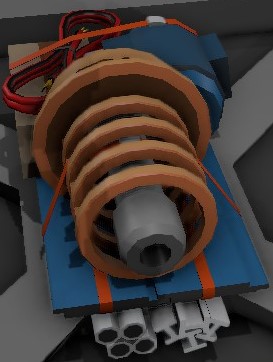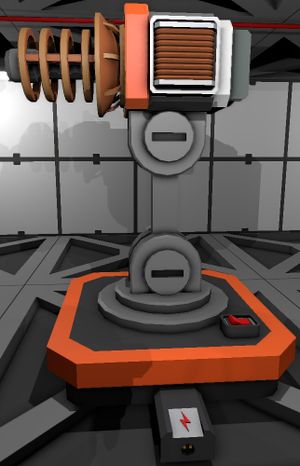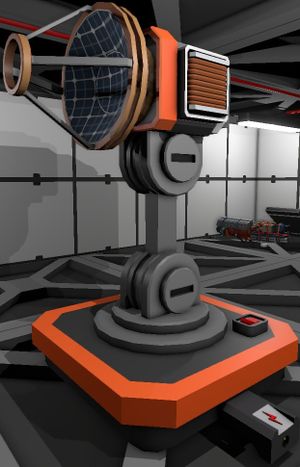Difference between revisions of "PowerTransmitter"
From Unofficial Stationeers Wiki
(added behaviour, range and math) |
m |
||
| Line 79: | Line 79: | ||
| − | ==Notes== | + | ===Notes=== |
*The vertical calculation uses atan, the horizontal uses atan2. | *The vertical calculation uses atan, the horizontal uses atan2. | ||
*The delta values are not constants, but they only change a little bit. | *The delta values are not constants, but they only change a little bit. | ||
| − | *When delta-z = 0, atan2() | + | *When delta-z = 0, atan2( delta-x / delta-z) still works |
*When calculating the Horizontal Hypotenuse, both options gives the same value, but causes divisions by 0 at different angles. | *When calculating the Horizontal Hypotenuse, both options gives the same value, but causes divisions by 0 at different angles. | ||
| − | *If you think that atan2( delta-x / delta-z ) looks flipped, it's because it is. What causes the flip are the devices themselves. When | + | *If you think that atan2( delta-x / delta-z ) looks flipped, it's because it is. What causes the flip are the devices themselves. When the head rotates horizontally in the positive direction they are actually rotating in what is normally considered the negative direction, and when the head points towards the data port it already has a 90° rotation. |
</translate> | </translate> | ||
Revision as of 18:42, 25 November 2021
| Properties | |
|---|---|
| Stacks | Yes (10) |
| Recipe | |
| Created With | Electronics Printer |
| Cost | 5 Gold, 7 Copper, 3 Steel |
| Operation | |
|---|---|
| Power Usage | 10W |
| Construction | |
| Placed with | Kit (PowerTransmitter) |
| Placed on | Large Grid |
| Stage 1 | |
| Deconstruction | |
| Deconstructed with | Hand Drill |
| Item received | 3x Electronic Parts |
| Stage 2 | |
| Deconstruction | |
| Deconstructed with | Hand Drill |
| Item received | 2x Iron Sheets |
| Stage 3 | |
| Deconstruction | |
| Deconstructed with | Hand Drill |
| Item received | Kit (PowerTransmitter) |
| Operation | |
|---|---|
| Power Usage | 10W |
| Construction | |
| Placed with | Kit (PowerTransmitter) |
| Placed on | Large Grid |
| Stage 1 | |
| Deconstruction | |
| Deconstructed with | Hand Drill |
| Item received | 1x Electronic Parts |
| Stage 2 | |
| Deconstruction | |
| Deconstructed with | Hand Drill |
| Item received | 2x Iron Sheets |
| Stage 3 | |
| Deconstruction | |
| Deconstructed with | Hand Drill |
| Item received | Kit (PowerTransmitter) |
Contents
[hide]Description
The Norsec Wireless Power Transmitter is an uni-directional, A-to B, far field microwave electical transmission system. The rotatable base transmitter delivers a narrow, non-lethal Microwave beam to a dedicated base receiver.
The transmitter must be aligned to the base station in order to transmit any power. The brightness of the transmitter's collimator arc provides an indication of transmission intensity. Note that there is an attrition over longer ranges, so the unit requrires more power over greater distances to deliver the same output.
General behaviour
- 5kW is the maximum PowerPotential that can be transmitted, this amount is reduced by distance.
- Device rotation matters. The default placement is to point the data port north (towards 0° on the compass), other directions will require adding or subtracting angles after doing the math below.
- The coordinates of these devices will change when the head moves.
- Both structures and terrain will block the beam.
- Storms have no effect on the power transfer.
- Using two emitters on the same reciever doesn't appear to work
- A Logic Transmitter can mirror recievers, but not emitters.
Range
Power transfer with 4000 W PowerPotential
98m = 3630 W (-0.37kW)
198m = 2863 W (-1.14kW)
300m = 1409 W (-2.59kW)
400m = 0 W
Power transfer with 5000 W PowerPotential
98m = 4630 W (-0.37kW)
198m = 3863 W (-1.14kW)
300m = 2409 W (-2.59kW)
400m = 651 W (-4.35kW)
Alignment formulas
All dataports points north, the delta values are calculated from: "reciever coordinate" - "emitter coordinate"
Horizontal angle at "emitter" (in radians) = atan2( delta-x / delta-z )
Horizontal angle at "emitter" (in degrees) = Horizontal angle at "emitter" (in radians) * 180 / pi
Horizontal angle at "reciever" (in degrees) = 180 + Horizontal angle at "emitter" (in degrees)
Horizontal Hypotenuse (option 1) = delta-z / cos(Horizontal angle at "emitter" (in radians))
Horizontal Hypotenuse (option 2) = delta-x / sin(Horizontal angle at "emitter" (in radians))
Vertical angle at "emitter" (in degrees) = 90 + atan( delta-y / Horizontal Hypotenuse ) * 180 / pi
Vertical angle at "reciever" (in degrees) = 180 - Vertical angle at "emitter" (in degrees)
Notes
- The vertical calculation uses atan, the horizontal uses atan2.
- The delta values are not constants, but they only change a little bit.
- When delta-z = 0, atan2( delta-x / delta-z) still works
- When calculating the Horizontal Hypotenuse, both options gives the same value, but causes divisions by 0 at different angles.
- If you think that atan2( delta-x / delta-z ) looks flipped, it's because it is. What causes the flip are the devices themselves. When the head rotates horizontally in the positive direction they are actually rotating in what is normally considered the negative direction, and when the head points towards the data port it already has a 90° rotation.



